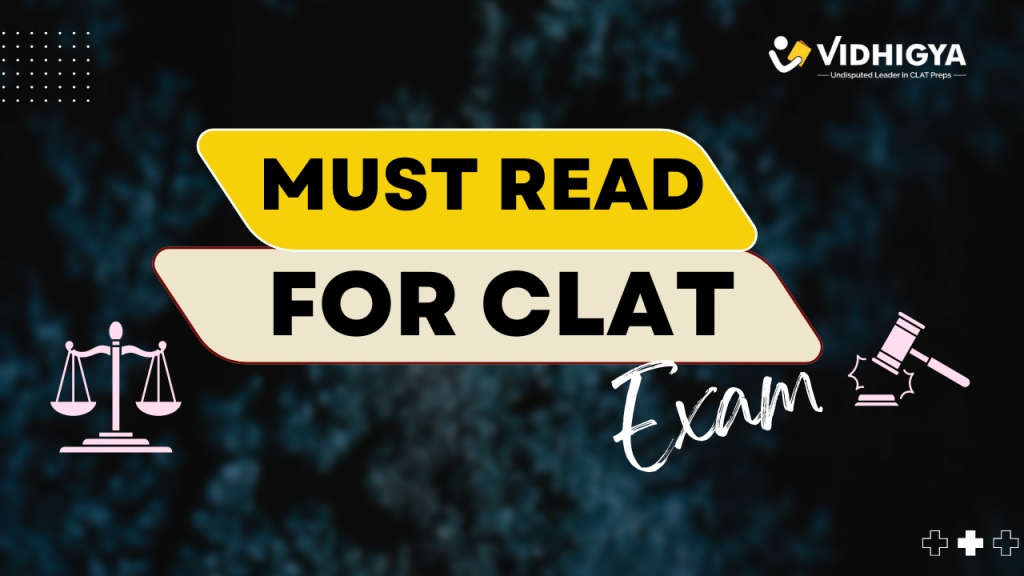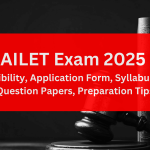The Common Law Admission Test (CLAT) is the primary entrance examination for undergraduate and postgraduate law programs in India.
It opens doors to prestigious National Law Universities (NLUs) and numerous private law institutions.
1. What is CLAT?
The CLAT exam is a centralized entrance test for students seeking admission to 22 NLUs across India.
Apart from these NLUs, many private law colleges also accept CLAT scores. Administered by the Consortium of National Law Universities, the exam primarily assesses students’ aptitude, comprehension, reasoning, and general knowledge.
2. Exam Format and Structure
The CLAT exam is a two-hour test and is conducted offline, i.e., pen-and-paper mode. There are two versions of the exam: one for undergraduate (UG) programs and another for postgraduate (PG) programs. Each exam type has its own structure and sections.
- UG CLAT: This consists of 150 questions spread across five sections: English Language, Current Affairs & General Knowledge, Legal Reasoning, Logical Reasoning, and Quantitative Techniques.
- PG CLAT: This exam is intended for LLM aspirants and includes sections on Constitutional Law, Jurisprudence, and other areas of law.
Key Highlights:
- Duration: 2 hours
- Total Questions: 150 (UG) and 120 (PG)
- Marks per Question: 1 mark
- Negative Marking: -0.25 for each incorrect answer
3. Syllabus Breakdown
English Language
- Comprehension Passages: Candidates need to interpret and analyze passages, focusing on tone, theme, and author’s perspective.
- Grammar and Vocabulary: Tests basic grammar rules, synonyms, antonyms, and contextual vocabulary.
Current Affairs & General Knowledge
- Static GK: Topics include history, geography, economics, and significant events.
- Current Affairs: Questions are based on recent news and events from politics, science, technology, sports, and international relations.
Legal Reasoning
- Principles of Law: Students analyze principles and apply them to different fact situations.
- Situational Judgments: These questions evaluate how well a student can deduce outcomes in hypothetical legal scenarios.
Logical Reasoning
- Critical and Analytical Reasoning: Involves arguments, conclusions, logical deductions, analogies, and other critical reasoning questions.
- Pattern Recognition: Focuses on syllogisms, series, and other forms of pattern-based questions.
Quantitative Techniques
- Basic Mathematics: Tests basic numerical skills, such as percentages, averages, ratios, and simple algebra.
- Data Interpretation: Graphs, tables, and other data sets are analyzed, requiring mathematical insights.
4. Eligibility Criteria
To be eligible for the CLAT UG exam:
- Education Qualification: Candidates must have completed 10+2 or equivalent exams.
- Minimum Marks: General category candidates must have 45% in their qualifying exams, while SC/ST candidates require 40%.
- Age Limit: There is no upper age limit.
For CLAT PG:
- Education Qualification: A bachelor’s degree in law is required.
- Minimum Marks: 50% for General and 45% for SC/ST candidates.
5. Registration and Application Process
Step 1: Online Registration
- Candidates register on the CLAT official website by filling out their details, such as name, email, and phone number.
Step 2: Filling the Application Form
- Fill in academic information, preferred NLUs, and upload documents such as photographs and signatures.
Step 3: Payment of Fees
- The application fee varies by category, generally around INR 4,000 for General/OBC and INR 3,500 for SC/ST candidates.
Step 4: Submission and Confirmation
- Verify all information and submit the application form. Download the confirmation page for future reference.
6. Preparation Tips for CLAT
Understand the Syllabus and Exam Pattern
- Familiarize yourself with the syllabus and focus on sections that carry more weight in the exam.
Practice Regularly
- Consistent practice is crucial for time-bound exams like CLAT. Practice mock tests and previous papers to build speed and accuracy.
Improve Reading Speed
- CLAT involves extensive reading. Regularly read newspapers, magazines, and legal articles to enhance your reading and comprehension abilities.
Focus on Current Affairs
- Current events and GK are crucial in the CLAT exam. Make a habit of reading daily news and current affairs resources to stay updated.
Work on Time Management
- Time management is vital for attempting all questions accurately. Practice solving questions with a timer to ensure efficiency on exam day.
Stay Positive and Consistent
- CLAT preparation can be rigorous, so staying positive, taking breaks, and keeping a steady pace can improve focus and motivation.
7. Important Resources for CLAT
- Standard Books: “Word Power Made Easy” for vocabulary, “Verbal and Non-Verbal Reasoning” by R.S. Aggarwal for reasoning skills.
- Online Platforms: Many online sites offer mock tests and current affairs updates tailored for CLAT.
- Newspapers and Magazines: The Hindu, Indian Express, and legal journals are excellent for improving reading comprehension and GK.
8. Mock Tests and Their Importance
Mock tests are integral to CLAT preparation, helping you understand the exam structure, improve speed, and identify areas of weakness. Regular mock tests also give insights into the areas that require more focus.
9. CLAT Cut-Offs and Admission Process
- Cut-Offs: CLAT cut-offs vary each year based on the difficulty level, the number of candidates, and available seats. Generally, top NLUs have higher cut-offs.
- Counseling Process: After the results, qualifying students participate in a centralized counseling process to allocate seats in their preferred NLU.
10. Common Mistakes to Avoid in CLAT Preparation
- Skipping Mock Tests: Regular mock tests are crucial for evaluating progress.
- Ignoring Time Management: Practicing under timed conditions is essential for managing exam pressure.
- Neglecting Current Affairs: General Knowledge is highly weighted, so stay updated on current events.
- Blind Guessing: CLAT has negative marking, so avoid random guesses.
11. Career Opportunities Post-CLAT
Clearing the CLAT exam and graduating from a top NLU opens diverse career paths:
- Corporate Lawyer: Advising businesses on legal matters, mergers, and acquisitions.
- Litigation Lawyer: Representing clients in court.
- Judicial Services: Becoming a judge by appearing for the judicial services exam.
- Academia: Pursuing a career in teaching law.
- Public Prosecutor: Representing the government in criminal cases.
12. Conclusion
The CLAT exam is a gateway to a fulfilling career in law and justice. A well-structured preparation strategy, consistent practice, and awareness of common pitfalls can significantly increase your chances of success. Focus on each section, stay informed on current affairs, and make mock tests your best friend. With dedication and the right approach, achieving a high CLAT score is within reach!



